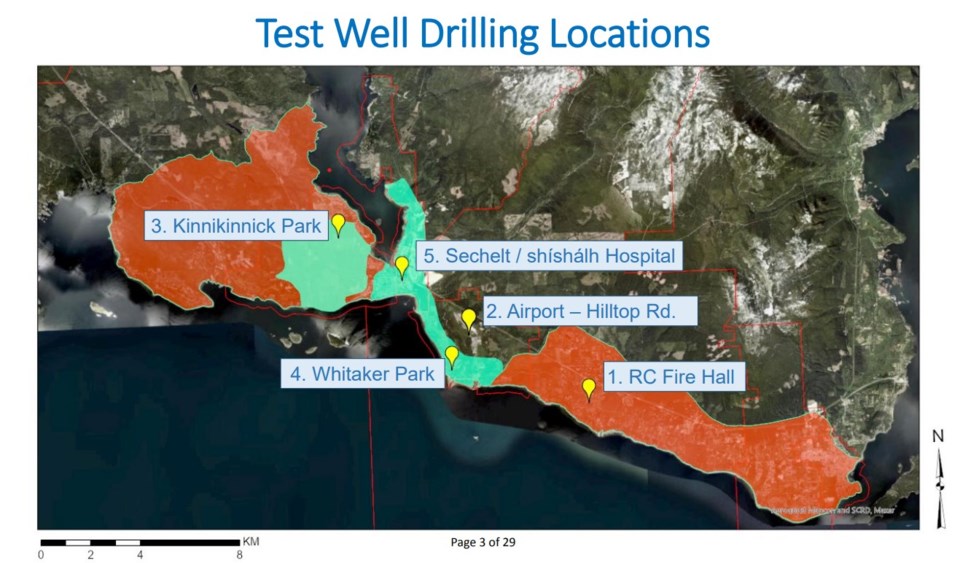“We kinda hit the jackpot here,” was committee chair and Elphinstone area director Donna McMahon’s reaction to a report regarding the Sunshine Coast Regional District’s (SCRD) most recent test well drilling program to locate groundwater sources to add to its Chapman Water System.
The report came forward at a April 10 committee of the whole meeting.
Of the five sites described in that document, a test well near Sechelt | shíshálh Hospital showed the best results, producing 22 litres per second. In her presentation at the meeting consultant Ineke Kalwij described that as the maximum volume possible in the six-inch (15 centimetre) piping used in the test drilling.
“Potentially a very productive aquifer at this location,” was Kalwij’s comment about the site. She added that water from the test well met drinking water quality standards, had no measurable saltwater intrusion and no discernible impact on other area wells was detected in the testing program. Regional staff at the meeting indicated water from the site tested as “ready to drink” if chlorinated.
While further testing is needed to confirm the early exploration results, Kalwij estimated the output of a production well at the site could yield 74 litres per second. In comparison, SCRD manager of infrastructure services advised the committee the Church Road well, commissioned in mid-2023, produces 55 litres per second.
Same or different aquifer as Dusty Road?
The major question raised at the committee table related to whether that test well accessed the same aquifer that feeds the Dusty Road test well. In 2023, the current SCRD board voted against reconsidering support for further development of that well, based on advice provided by a consultant that the unconfined aquifer feeding that site could be subject to contamination from nearby industrial uses and the Sechelt landfill.
While early indications are that the hospital site water is coming from a different source, both staff and Kalwij stressed the need for further exploration to confirm that.
Next steps
To get that work under way, the committee endorsed all staff recommendations on the matter. If those are endorsed by the board, the SCRD will be advancing engagement with shíshálh Nation and Vancouver Coastal Health (VCH) about developing the water source.
The potential for a new well to provide a direct water supply for the hospital, eliminating the need for that facility to construct on-site water storage for use when other supplies on the Chapman system are restricted or compromised, is anticipated to be a consideration in talks with VCH.
Also recommended is for the region to apply for a water licence and initiate groundwater monitoring for the hospital test well site.
The financial implications associated with further wellfield development at the site are to be prepared for board consideration and an update on strategic water supply expansion scenarios, including new groundwater and reservoir sources, is to come forward at a May committee meeting.
Sechelt area director Adam Shepherd voiced the view that consultation with the Nation should be “a first step." His view was that both parties need to consider “how this fits with their plans for the reservoir," especially in the area of the costs to develop a well in comparison to reservoir construction.
Alternate Area A director, Christine Alexander asked about the fit of this potential new development and the additional workload it could bring with existing staff capacity. Rosenboom stated the work that is proposed to be done is within current staff resources and that reallocation of resources to the project could be considered if required, should it proceed to the development phase.
Other results
The test well drilling program also looked into sites near the Roberts Creek Fire Hall, the airport, as well as at Kinnikinnick and Whitaker Parks. All hit water but none showed results as promising as the drilling near the hospital. The airport location produced 4.6 litres per second (based on 72-hour pumping tests) almost five times less than at the hospital and came in a distant second in volume of water accessed, according to the report.


.png;w=120;h=119;mode=crop)
.png;w=120;h=80;mode=crop)